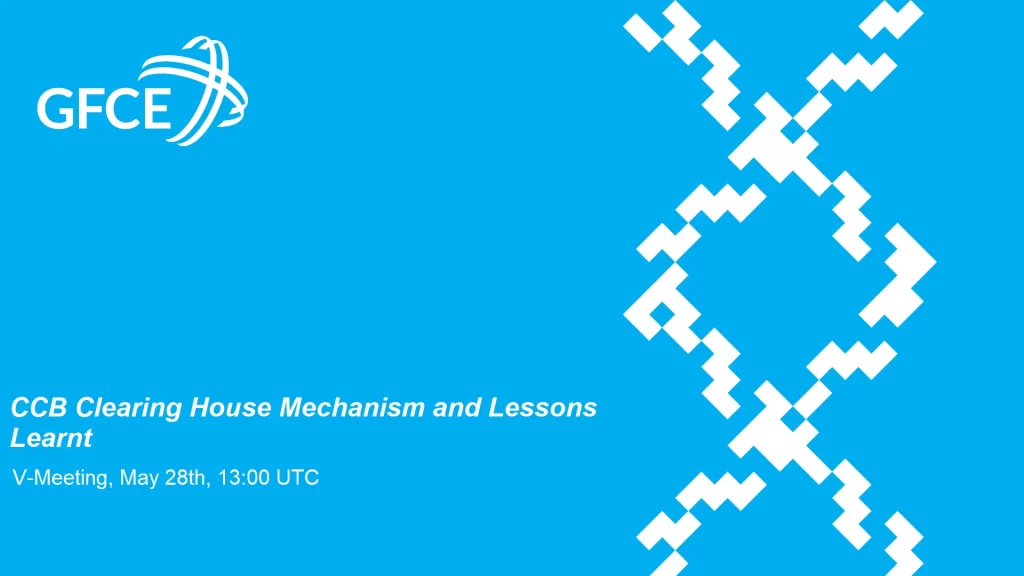Report on the “CCB Clearing House Mechanism and Lessons Learnt” Session
Report | GFCE V-Meeting “CCB Clearing House Mechanism and Lessons Learnt” | 28 May 2020
The GFCE Clearing House aims to facilitate matchmaking between GFCE Members and Partners who have cyber capacity needs with those that can offer cyber capacity support. The aim of the session was to refine the draft clearing house mechanism so it becomes clear what the GFCE Clearing House is, how we can coordinate requests from Members efficiently and how the community can join and support the process. Participants were invited to this interactive session and given the opportunity to provide their input on important first elements of the process, using the interactive software Mentimeter.
Manon van Tienhoven, Program Coordinator of the GFCE Secretariat, opened the session and explained the experiences the GFCE has had over the past 1,5 years regarding its clearing house function and the importance of this process for the GFCE in general, but also for global cyber capacity building. With an effective global clearing house mechanism, the GFCE hopes to improve efficiency on a global level in the delivery of capacity building programs through coordination, knowledge sharing and avoiding the duplication of efforts. Multiple GFCE members and partners already have experience with the GFCE clearing house, and three representatives were invited to reflect on the added value of the GFCE clearing house to cyber capacity building and also to name a lesson learnt how the GFCE can improve this process.
First of all, Sanusi Drammeh, Principal ICT Officer at the Ministry of Information & Communication Infrastructure of The Gambia, presented on The Gambia’s experience with the GFCE clearing house as requesting member for cyber capacity support. He addressed how the GFCE has provided opportunities for The Gambia to connect, network and contribute to cyber capacity building, e.g. with activities such as national strategy and policy development (e.g. updating the National Cyberspace Security Policy, Strategy and Action Plan, establishing the GM-CSIRT). A lesson learnt for the GFCE is that there are already good processes, but that these are quite lengthy as well as that a formal response to a requesting country should be considered.
The second speaker was Daniela Schnidrig¸ Programme Lead for Global Partners Digital, who have been involved in the GFCE clearing house process in Sierra Leone about their national cyber security strategy. She underlines the big challenge in the cyber capacity field with donors and implementers who are involved in the same environment with activities and projects that have a similar focus, but who are not connected which can result in overlap and duplication of efforts. Another risk is that this can cause support fatigue with the receiving countries. She highlights that the GFCE has a valuable role in coordinating the broader picture and understanding what other implementers are doing in the clearing house helps build trust in the network. Nonetheless, something that can be improved is that more resources and capacity is needed at the GFCE to better support this critical function.
Hein Dries, Key Expert cybercrime at OCWAR-C, was the third speaker of the session and he reflected on his experience with the GFCE clearing house through the OCWAR-C project that covers 16 countries in Western Africa. There is value in the GFCE clearing house function because this coordinating role helps actors to know who is there and who is doing what. He highlights two lessons learnt. First of all, that it is important to narrow down the big requests to small building blocks that can be linked to manageable projects. Secondly, the need to consider the regional level sometimes instead of the national level.
After the presentations, the draft GFCE Clearing House mechanism was presented by the GFCE Secretariat that was split in three phases: 1) Preparatory phase, 2) Coordinating phase, and 3) Implementation phase. This process is developed based on the ongoing Clearing House cases in order to explain the process and maximize efficiency. The mechanism considers also the lessons learnt from the GFCE Secretariat’s perspective from the past 1,5 years: to ensure there is a political mandate of the requesting country and to refine the capacity needs to concrete deliverables.
Manon also elaborated that throughout the entire GFCE clearing house process, the GFCE Community has a significant role to play. Therefore, the questions prepared on Mentimeter were aimed to get feedback from the community on the draft mechanism and on the lessons learnt. The Mentimeter slides used during the session with the responses can be found here.
Based on the fruitful discussion and valuable input from the Community, the GFCE Secretariat is working on refining the process and further clarifying roles and responsibilities. If you have more questions or would like to provide further advice or suggestions, please get in contact with us at contact@thegfce.org.
